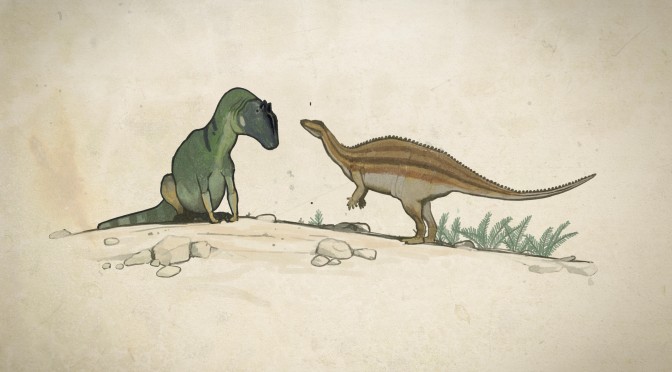Review of: John Conway, C.M. Kosemen & Darren Naish (2012). All Yesterdays. Unique and Speculative Views of Dinosaurs and Other Prehistoric Animals. London: Irregular Books. Price: (Amazon Kindle E-book) or (Printed version via Lulu.com).
By Ilja Nieuwland
‘Paleo-art’, or the art of restoring extinct life, has experienced a number of paradigmatic changes during its two-hundred-or-so-years history, closely tied to the way in which scientists viewed it. Not so much in style perhaps – as Bill Mitchell noted, ‘there’s little use for cubist dinosaurs’ – but certainly in its view of extinct animals, and particularly dinosaurs. From elephantine behemoths, via agile aggressors, through insipidly lumbering heaps of meat to the active, intelligent semi-birds of today, each era has generated its own science, and its own art. And the first idea that popped into my mind when viewing All Yesterdays was that we had arrived at another new age.
The premise for All Yesterdays is relatively simple: speculate wildly about the way dinosaurs looked with soft tissues (feathers, lumps, sacs etc.) that we don’t know (and mostly can’t know) from the fossil record. What Conway et al. rile against is the presumption that because we have no information, it is somehow unethical to see. The point is that we do have quite a bit of information about how reptiles and birds look – they’re around us. Birds are the dinosaurs’ closest relatives; it is therefore not unreasonable (albeit admittedly untestable) to assume that the current variety in bird appearance is comparable to that of at least the smaller dinosaurs.

Another issue that is tackled by the authors concerns behavior. Since the early nineteenth century, dinosaurs have been portrayed as perennially-hungry hunting monsters; that meant overexposure of predators, which were virtually always depicted whilst hunting some unfortunate animal. The Jurassic Park movies have done much to cement this image in the mind of the public, but even documentary series such as Walking with Dinosaurs showed (very noisy) dinosaur that appeared to be occupied with little else than mutual extermination. In real nature, predators spend only a small percentage of their time hunting – as anyone with a cat can testify, sleeping (digesting, saving energy) is what they’re best at. Yet we rarely see them portrayed as such.
It also occurred to me that despite the valuable accuracy of Greg Paul’s (or Greg Paul-like) lateral skeletal reconstructions, they created an unwanted side effect. The bones might be real, but the resulting body outlines were much more speculative; moreover, the aggressive, active posture of such ‘skeletals’ loaded what was supposed to be an anatomical study piece with behavioral preconceptions. Yet, the work of Paul and his followers has set the standard for dinosaur depiction for a long time, and has – in my view at least – the habit of showing ‘shrink-wrapped’ dinosaurs.
The problems with that approach are amply demonstrated in the book’s second part, ‘All Todays’. Here we see what a potential future paleontologist might have made of animals that are with us today. Cats, cows, rhinoceroses and hippopotamuses are transformed into simultaneously horrific and hilarious creatures. Of course, this is hyperbole, but it is instructive to be confronted with all the preconceptions that we use to reconstruct extinct life.
I can’t recommend All Yesterdays enough, not least because it is a very beautiful book. Particularly John Conway’s images convey an atmosphere that you won’t find in any other paleontology book. Yes, it is speculative – but it never claims otherwise. And no, it is not perfect. But it also confronts us with a daring attempt at a new paradigm of extinct fauna as one that consisted of real animals, and defined by real animal behavior.

You can buy All Yesterdays as an e-book or in a dead trees version.
o-o-o
Ilja Nieuwland works at the Huygens ING, an institute of the Royal Netherlands Academy of Arts and Scienes. His specialization in the history of 19th- and 20th-century paleontology is an unfortunate but unavoidable consequence of the fact that he was never able to shake off the interest in dinosaurs he held as an eight-year-old

